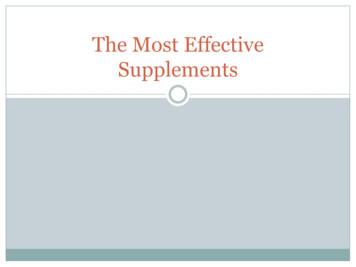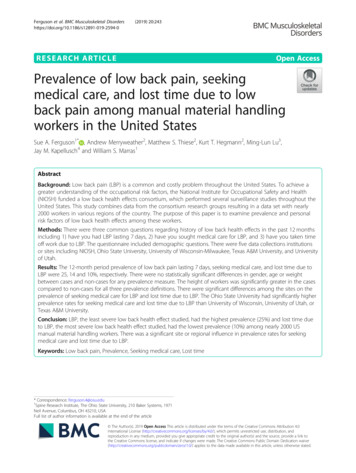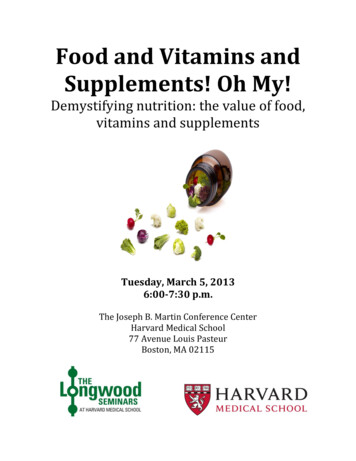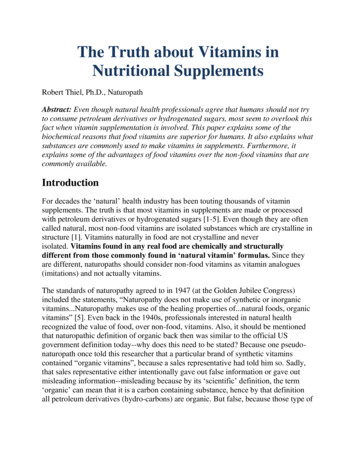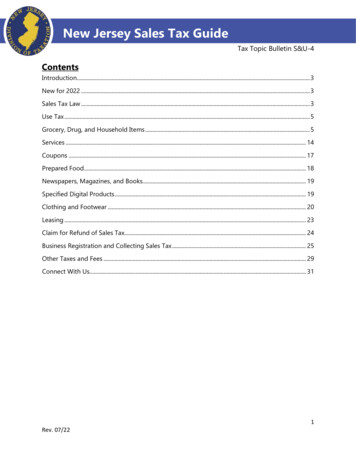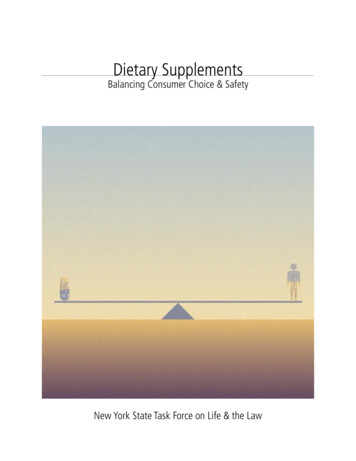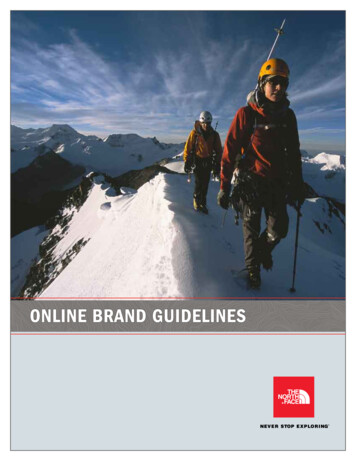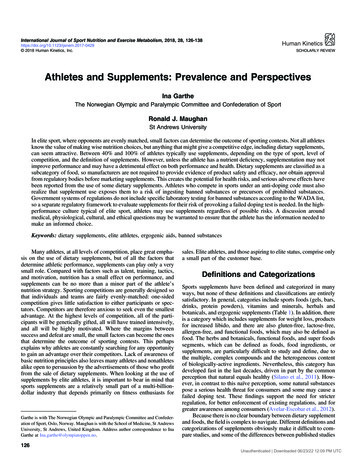
Transcription
International Journal of Sport Nutrition and Exercise Metabolism, 2018, 28, 126-138https://doi.org/10.1123/ijsnem.2017-0429 2018 Human Kinetics, Inc.SCHOLARLY REVIEWAthletes and Supplements: Prevalence and PerspectivesIna GartheThe Norwegian Olympic and Paralympic Committee and Confederation of SportRonald J. MaughanSt Andrews UniversityIn elite sport, where opponents are evenly matched, small factors can determine the outcome of sporting contests. Not all athletesknow the value of making wise nutrition choices, but anything that might give a competitive edge, including dietary supplements,can seem attractive. Between 40% and 100% of athletes typically use supplements, depending on the type of sport, level ofcompetition, and the definition of supplements. However, unless the athlete has a nutrient deficiency, supplementation may notimprove performance and may have a detrimental effect on both performance and health. Dietary supplements are classified as asubcategory of food, so manufacturers are not required to provide evidence of product safety and efficacy, nor obtain approvalfrom regulatory bodies before marketing supplements. This creates the potential for health risks, and serious adverse effects havebeen reported from the use of some dietary supplements. Athletes who compete in sports under an anti-doping code must alsorealize that supplement use exposes them to a risk of ingesting banned substances or precursors of prohibited substances.Government systems of regulations do not include specific laboratory testing for banned substances according to the WADA list,so a separate regulatory framework to evaluate supplements for their risk of provoking a failed doping test is needed. In the highperformance culture typical of elite sport, athletes may use supplements regardless of possible risks. A discussion aroundmedical, physiological, cultural, and ethical questions may be warranted to ensure that the athlete has the information needed tomake an informed choice.Keywords: dietary supplements, elite athletes, ergogenic aids, banned substancesMany athletes, at all levels of competition, place great emphasis on the use of dietary supplements, but of all the factors thatdetermine athletic performance, supplements can play only a verysmall role. Compared with factors such as talent, training, tactics,and motivation, nutrition has a small effect on performance, andsupplements can be no more than a minor part of the athlete’snutrition strategy. Sporting competitions are generally designed sothat individuals and teams are fairly evenly-matched: one-sidedcompetition gives little satisfaction to either participants or spectators. Competitors are therefore anxious to seek even the smallestadvantage. At the highest levels of competition, all of the participants will be genetically gifted, all will have trained intensively,and all will be highly motivated. Where the margins betweensuccess and defeat are small, the small factors can become the onesthat determine the outcome of sporting contests. This perhapsexplains why athletes are constantly searching for any opportunityto gain an advantage over their competitors. Lack of awareness ofbasic nutrition principles also leaves many athletes and nonathletesalike open to persuasion by the advertisements of those who profitfrom the sale of dietary supplements. When looking at the use ofsupplements by elite athletes, it is important to bear in mind thatsports supplements are a relatively small part of a multi-billiondollar industry that depends primarily on fitness enthusiasts forGarthe is with The Norwegian Olympic and Paralympic Committee and Confederation of Sport, Oslo, Norway. Maughan is with the School of Medicine, St AndrewsUniversity, St Andrews, United Kingdom. Address author correspondence to InaGarthe at Ina.garthe@olympiatoppen.no.sales. Elite athletes, and those aspiring to elite status, comprise onlya small part of the customer base.Definitions and CategorizationsSports supplements have been defined and categorized in manyways, but none of these definitions and classifications are entirelysatisfactory. In general, categories include sports foods (gels, bars,drinks, protein powders), vitamins and minerals, herbals andbotanicals, and ergogenic supplements (Table 1). In addition, thereis a category which includes supplements for weight loss, productsfor increased libido, and there are also gluten-free, lactose-free,allergen-free, and functional foods, which may also be defined asfood. The herbs and botanicals, functional foods, and super foodssegments, which can be defined as foods, food ingredients, orsupplements, are particularly difficult to study and define, due tothe multiple, complex compounds and the heterogeneous contentof biologically-active ingredients. Nevertheless, this category hasdeveloped fast in the last decades, driven in part by the commonperception that natural equals healthy (Silano et al., 2011). However, in contrast to this naïve perception, some natural substancespose a serious health threat for consumers and some may cause afailed doping test. These findings support the need for stricterregulation, for better enforcement of existing regulations, and forgreater awareness among consumers (Avelar-Escobar et al., 2012).Because there is no clear boundary between dietary supplementand foods, the field is complex to navigate. Different definitions andcategorizations of supplements obviously make it difficult to compare studies, and some of the differences between published studies126Unauthenticated Downloaded 06/23/22 12:09 PM UTC
Athletes and SupplementsTable 1127Categorization of Supplements by UseCategory by UseExamplesComments: Risk-AssessmentsSports foods: Specialized productsused to provide a practical source ofnutrients when it is impractical toconsume everyday foodsMedical supplements: Used to treatclinical issues, including diagnosednutrient deficienciesErgogenic supplements: Supplementsintended to enhance performanceSports drink, sports gel, liquid meal,sports confectionery, sports barMost sports foods, but not all, are low risk for contamination withprohibited substances.Iron, calcium, multivitamin/mineral,vitamin D, probiotics (gut/immune)Most—but not all—vitamin and mineral supplements purchased ata pharmacy are produced with a strict pharmaceutical control.Functional food and superfoods:Purported to optimize health andperformanceOther supplements: Includes a widerange of herbal and botanical extractsand concentratesCaffeine, β-alanine, bicarbonate, nitrate Ergogenic supplements that are not on the World Anti-Doping(beetroot juice), creatineAgency (WADA) prohibited list are concentrates of substancesfound in food. There is a risk of cross-contamination with prohibited or harmful substances and of deliberate adulteration by theaddition of pharmaceutical agents.Herbs, seaweed, spirulina organic food, No guarantee of the amount of active biological substance. Productplant fibers, seeds (chia seeds), natural heterogeneity makes it hard to identify and categorize biologicallyalkalizing fruits, raw juice and berry,active ingredients. Herbal or traditional products, including animal(acai, goji) extractsand plant materials, are found principally in Chinese, Korean, and/or herbal medicine prescriptions. Governmental regulation andpolicies differ between countries.Supplements for: weight loss (shakes, May contain central nervous system stimulants (e.g., ephedrine)tablets), increased energy, increasedand hormones or hormone precursors (e.g., norandrostenedione andlibido, prevention of hair lossnorandrostenediol). They are considered high risk for adulterationdue to the need for rapid and noticeable results by the consumer topromote continued use of the product. To achieve these results,potent pharmaceuticals are sometimes added by the manufacturers.are simply due to different definitions. A recent meta-analysis onsupplement use by athletes identified several challenges to theinterpretation of the published evidence regarding the prevalenceof supplement use within sport (Knapik et al., 2016). The majormethodological challenges in the literature seem to be: Different definitions of supplements Diverse populations and level of performance Different methods of data collection Different timeframesGovernmental DefinitionsThe US Food and Drug Administration (FDA) has the followingdefinition of supplements: “A dietary supplement is a productintended for ingestion that contains a ‘dietary ingredient’ intendedto add further nutritional value to (supplement) the diet” (FDA,2017). A “dietary ingredient” may be one, or any combination, ofthe following substances (in tablets, capsules, softgels, gelcaps,liquids, or powders): Vitamins Minerals Herbs or other botanicals Amino acids Dietary substances for use by people to supplement the diet byincreasing the total dietary intake Concentrates, metabolites, constituents, or extractsAs dietary supplements are classified as a subcategory of food,manufacturers are not required to provide evidence of productsafety and efficacy (Denham, 2017). While medications anddrugs are governed by rigid pharmaceutical regulation, based onpremarketing authorization and end-product control, dietary supplement manufacturers and distributors are not required to obtainapproval from the FDA before marketing dietary supplements. Thiscreates a substantial potential risk to the health of the public, andserious adverse effects have been reported from some dietarysupplements that are currently being marketed (FDA, 2017).Supplements are regulated on a national rather than globalbasis and regulations vary between countries. Before marketing adietary supplement in the United States, the manufacturers areresponsible for ensuring that the specific regulations are followed: The products it manufactures or distributes are safe Any claims made about the products are not false ormisleading The products comply with the Federal Food, Drug, andCosmetic Act and FDA regulations in all other respectsIn Europe, the European Food Safety Authority (EFSA) hassimilar regulations and definitions on dietary supplements, and hasestablished a framework for regulation of vitamin and mineralsupplements to protect consumers against potential health risksand to ensure that they are not provided with misleading information(Directive 2002/46/EC, EFSA, 2017). They provide a list of vitamins and minerals that may be added for nutritional purposes, withspecific upper and lower limits of vitamin and minerals (Directive2002/46/EC, EFSA, 2017). With the level of resources required tocontrol these marketing and safety regulations in this fast-growingsegment, it is reasonable that the responsibility for committing tothose regulations lies with the manufacturer. However, it can alsocreate some challenges. In most countries, these regulations areenforced by periodic, but often infrequent, testing of random samples(Norwegian Food Safety Authority, 2017; FDA, 2017). Regulatorybodies must prove adulteration or misbranding or risk of illness/injury before a dietary supplement can be removed from the market.This is time-consuming and requires substantial resources.IJSNEM Vol. 28, No. 2, 2018Unauthenticated Downloaded 06/23/22 12:09 PM UTC
128Garthe and MaughanAccording to marketing regulations in the United States, adietary supplement cannot claim to diagnose, treat, cure, or preventany disease. However, a study of 443 websites of 8 bestselling herbalproducts showed that 81% made one or more health claims; 55%claimed the product treated, prevented, diagnosed, or cured specificdiseases; and 52% of those making claims omitted the federaldisclaimer (Morris & Avorn, 2003). In another study, 75% of themost popular herbal supplements did not include on the label the keysafety messages about warnings for medical conditions, drug interactions, and side effects (Raynor et al., 2011). Undoubtedly, stricterenforcement of the existing regulations that apply to manufacturersand distributors is needed, but, without the necessary resources to dotests and follow-up, the effect will continue to be limited.The government systems of regulations and independentmanufacturing quality programs do not include specific laboratorytesting for banned substances according the World Anti-DopingAgency (WADA) list. A separate regulatory framework to evaluatesupplements for their risk of provoking a failed doping test wouldbe needed, but there is limited interest from the regulatory bodies,perhaps because this represents such a small part of the market.Motivations for Supplement UseThere are several reasons why it is important to understand theathlete’s motivation for supplements use, whereas one reason is todevelop strategies for responsible supplement use. Another reasonis to minimize the risk of excessive and harmful supplement useand to separate sports foods and medical supplements (used to treatclinical issues) from the use of ergogenic supplements that areintended specifically to enhance performance. There may beseveral different motivational factors for each category of supplements; food and supplements containing essential nutrients (e.g.,vitamins) are mainly used for health reasons, with performanceeffects being secondary to better health, while ergogenic aids areused with the intention of maximizing performance. Further,athlete support staff may want to encourage a food-based approachto nutrition education, since the literature shows that most athletescan cover their nutrient needs through a varied diet, provided theenergy intake is moderate to high (Thomas et al., 2016).The final reason may be to identify the “gray zone”, whereathletes who use dietary supplements may be associated with anaccepting attitude of doping at a later stage (the “gateway” theory,presented by Backhouse et al., 2013). There are some data tosuggest that supplement users have more positive attitudes towarddoping, and that they believe that doping is an effective way toincrease performance (Backhouse et al., 2013). Others report thatthere seems to be an underlying cognitive component in theassociation between use of supplements and doping, and thatuse of supplements may influence reasoning patterns and themotivational incentive in favor of using prohibited substances ata later stage, even among adolescent athletes (Barkoukis et al.,2015). According to the literature, the prevalence of doping ishigher in supplement users than in athletes who do not usesupplements (Backhouse et al., 2013; Barkoukis et al., 2015). Itis, however, important to note that these studies were not designedto identify a direct causality between supplement use and doping.Prevalence of Supplement UseSurveys regarding use of dietary supplements in the generalpopulation have consistently shown that supplements are usedby a large part of the population, and this is substantiated bythe sales figures of what is now a multi-billion-dollar globalindustry (Hämeen-Anttila et al., 2011; Timbo et al., 2006). According to national surveys of the general population in the UnitedStates, more than 40% of the adult population used dietarysupplements in the period from 1988–1994, and this had increasedto over one-half during 2003–2006 (Centers for Disease Controland Prevention, 2011). The Council for Responsible Nutrition(CRN), an industry-funded body, has an annual survey on dietarysupplements, with a national sample of 2,007 adults aged 18 yearsliving in the United States. According to the most recent survey,71% of US adults (more than 170 million people) report use ofdietary supplements for the following reasons: “an overall health/wellness benefit”, “to get energy”, and “to fill nutrient gaps in mydiet” (CRN Consumer Survey on Dietary Supplements, 2016).That is an increase from 2015, where 68% reported intake ofdietary supplements (CRN Consumer Survey on DietarySupplements, 2015). The most used supplements were vitaminand mineral products. Supplement users aged 18–34 years reportedin 2015 that they anticipated their supplement use to increase overthe next 5 years. Data from the 2016 survey suggest that thisprojection is likely to be realized, as young adults are increasingtheir use of dietary supplements.Use of dietary supplements within athletic populations isreported to be relatively high in most studies (Baylis et al.,2001; Heikkinen et al., 2002; Kim et al., 2011; Lun et al.,2012) (Table 2). This agrees with the study by Sobal and Marquart(1994), who undertook a comprehensive analysis of publishedstudies of supplement use among collegiate athletes and eliteathletes. A total of 10,274 athletes, males and females, wereincluded in this meta-analysis, which showed that 46% of collegeathletes and 59% of elite athletes used dietary supplements (Sobal& Marquart, 1994).As mentioned above, the review and meta-analysis by Knapiket al. (2016) highlighted some of the challenges when comparingdata from different studies due to different methods of datacollection. For example, Lun et al. (2012) reported a supplementation use of 81–100% in a sample of 440 Canadian elite athletes, ofwhom 76% were competing at the international level. They foundan association between total weekly training hours and supplementuse, with an increasing prevalence from 67% for 5 weeklytraining hours to 95% for those training 25 hr/week. Not surprisingly, the most used supplements were sports supplements, whichare often recommended by professional support staff for use inrelation to training and competitions.The association between supplement use and training load,found by Lun et al. (2012), agrees with the review by Knapik et al.(2016) and with more recent reports by Erdman et al. (2006) andHeikkinen et al. (2002), who concluded that elite athletes usedmore supplements than nonelite athletes, and that sports supplements were the supplement used most commonly. Further, severalstudies show that athletes from endurance-based sports use supplements to a greater extent than athletes from other sport categories(Erdman et al., 2006; Heikkinen et al., 2002; Lun et al., 2012; Shawet al., 2016).An alternative way of assessing the prevalence of supplementuse is by analysis of declaration forms completed by athletes whoare selected for doping control. In these settings, the athletes areasked to declare any prescription or nonprescription medication,vitamins, food supplements, herbal products, and any other substance they have taken within the past 7 days. Table 2 shows thatathletes declare the use of a wide range of different supplements,IJSNEM Vol. 28, No. 2, 2018Unauthenticated Downloaded 06/23/22 12:09 PM UTC
IJSNEM Vol. 28, No. 2, 2018Unauthenticated Downloaded 06/23/22 12:09 PM UTC129Sundgot-Borgen et al.(2003)Wardenaar et al. (2017)Tsitsimpikou et al. (2009)Tscholl et al. (2008)Parnell et al. (2015)Petroczi & Naughton(2008)232 M & 334 F; 11–25 yearsAge-related groups76% national/provincial24% international 666 M; 23.2 4.7 years556 F; 21.4 4.6 yearsNorwegian athletesNational senior & junior teamsResponse rate: 76% M, 92% F11.5 years 226 F athletes; 22.0 7.6 years Elite (51%) & subelite (49%) Response rate: 43% 327 M athletes; 23.5 2463 athletes 1779 therapeutic use exception Athens Olympic Games 2004 736 M Professional soccer players World Cup 2002 & 2006 athletes Age 12–21 years Age-related groups Response rate:25% 260 M & 133 F British eliteletes, Atlanta Olympic Games1996; response rate: 95% 150 M & 150 F Canadian athletes, Sydney Olympic Games2000; response rate: 97% 121 M & 136 F Canadian ath-Population (M Male,F Female; mean SD)Questionnaire on dietarysupplements; current use24-hr dietary recall andquestionnaire on dietarysupplements; past4 MonthsDoping control; currentuseDoping control; 72 hr priorto matchQuestionnaire on dietarysupplements; past3 MonthsQuestionnaire on dietarysupplements used; currentand pastInterview with items ondietary supplements; current useMethods; TimeframeEchinacea: 8Caffeine: 6Ginseng: 2Creatine: 1359 M vs. 66 F Atlanta65 M vs. 58 F Sydney16 M vs. 45 F Atlanta30 M vs. 21 F Sydney35 M vs. 43 F Atlanta43 M vs. 51 F SydneyM vs. FSupplements:51 vs.54Vitamins:70 vs. 82Minerals:25 vs. 43Omega-3:36 vs. 37Energy drink:65 vs. 53Creatine:12 vs. 3Ginseng:9 vs. 597 anytime & 85 past 4 weeksVitaminsSports products:Vitamin C: 23Drinks/shakesVitamin D: 20Isotonic: 44Fatty acids: 16Recovery: 34ErgogenicProtein: 30Caffeine: 13Energy bars: 26Creatine: 9Food/sports supplements: 48Vitamins: 43Proteins: 14Vitamins: 41Minerals: 21Amino acids: 11Multivitamin/multimineral: 67Vitamin C: 66Vitamin D: 48Vitamin-enriched water: 65Protein powder: 51Energy drink: 42Vitamin C: 23Iron: 5Multivitamin: 23Protein: 21Nutritional SupplementsMineralsVitaminsOverall: 69 Atlanta, 74 SydneySupplement Categorization and Prevalence (%)Overview of Published Studies With Prevalence, Methods, and Reasons for Supplement Use in AthletesHuang, Johnson, and Pipe(2006)StudyTable 2(continued)(M vs. F)Increased performance(27% vs. 12%); preventing deficiencies (56% vs.67%); other (15% vs.13%)Not reportedNot reportedNot reportedPerformance (81%);medical issues (19%);improve diet (43%); stayhealthy (81%); immunesystem (52%)Maintain strength (72%);avoid sickness (56%);increase endurance(55%); train longer(30%); increase recovery(33%)Not reportedReasons forSupplement Use
130IJSNEM Vol. 28, No. 2, 2018Unauthenticated Downloaded 06/23/22 12:09 PM UTCWiens et al. (2014)Baylis et al. (2001)Karimian & Esfahani(2011)Erdman et al. (2006)Nieper (2005)Slater, Tan, and Teh(2003)Corrigan and Kazlauskas(2003)StudyTable 2 (continued) 567 athletes 11–25 years Age-related groups 40 M & 37 F Elite Australian swimmers Response rate 48% 250 M & 250 F Bodybuilders, Iran 30 bodybuilding clubs 19–28 yearsathletes National & developmentalteams Response rate: 98% 314 M & 268 F Canadian Elite Response rate: 94%18 years IAAF 2004 World Junior,Field Athletes 20 M & 12 F UK Junior National Track & 85 M & 75 F Elite athletes Singapore Response rate: 29%Games 2000 2758 athletes Sydney OlympicPopulation (M Male,F Female; mean SD)Face-to-face guided questionnaire; past 3 MonthsQuestionnaire on dietarysupplements; past6 MonthsSelf-administered supplements questionnaire/checklist; current useQuestionnaire on dietarysupplements; past6 MonthsQuestionnaire on dietarysupplements; past3 MonthsQuestionnaire on dietarysupplements; past12 MonthsDoping control; past 3daysMethods; TimeframeAll athletes: 98Multivitamin: 67Vitamin C: 66Vitamin B: 32Vitamin D: 48Vitamin-enriched water: 65Sports product: 95Multivitamins: 58Vitamin C: 73Herbs: 61Sports supplements: 87Overall: 49 (87 M vs. 11 F)Hormones: 17 vs. 0Creatine: 61 vs. 0Vitamins: 52 vs. 4Mineral: 15 vs. 10Overall: 88Sport drinks: 22Sport bars: 14Multivitamins and minerals: 14Protein supplements: 9Vitamin C: 6Overall: 94 (75 M vs. 55 F)Multivitamin: 45Vitamin C: 35Iron: 30Ergogenic aids: 45 M vs.11 FOverall: 77 (73 M vs. 81 F)Sports drink: 39Caffeine: 37Vitamin C: 33Multivitamin.: 21Vitamins: 51Minerals: 21Amino acids: 13Calcium: 43Iron: 27Fatty acids: 40Plant/herbal Extracts:47Muscle- building: 36Protein: 13Creatine: 16Ginseng: 15Sports bars: 15Protein: 13Other: 23Supplement Categorization and Prevalence (%)(continued)Stay healthy (81%);increase energy (55%);immune function (52%);recovery (49%); performance (49%)Not reported(M vs. F)Health (31% vs. 59%);immune (27% vs. 53%);performance (41% vs.9%)Increase energy (54%);health maintenance/prevent nutritional deficiency(54%); improve recovery(52%)(M vs. F)Increased health performance (45% vs. 33%);immune system (40% vs.44%); improve performance (25% vs. 11%)Increase energy; performance/build muscle; prevent/treat illness; Improvegeneral healthNot reportedReasons forSupplement Use
IJSNEM Vol. 28, No. 2, 2018Unauthenticated Downloaded 06/23/22 12:09 PM UTC131de Silva et al. (2010)Lun et al. (2012)Maughan et al. (2007)Kim et al. (2011)Heikkinen et al. (2011)Braun et al. (2009)StudyTable 2 (continued) Response rate: 88%ation Games (2006) 113 athletes 73 M & 40 F 15–35 years Sri Lanka, South Asian Feder- 163 M & 277 F 19.9 5.2 years Elite Canadian athletes 310 competitors IAAF World Championships76 F); Korean Olympic TeamBeijing (2008); response rate:96% Group B: 228 athletes (128 M &100 F); reserve team; responserate: 100% Group A: 161 athletes (85 M &Athletes 2002; 21.2 4.3 years;response rate: 90% 218 M & 154 F Finnish OlympicAthletes 2009; 23 4.5 years;response rate: 92% 261 M & 185 F Finnish Olympic 77 M & 87 F Elite German athletes 10–25 years (16.6 3.0) Age-related groups Response rate: 79%Population (M Male,F Female; mean SD)Questionnaire on dietarysupplements; past12 MonthsFace-to-face/group meetings while answering supplements questionnaire;past 6 MonthsQuestionnaire on dietarysupplementsQuestionnaire on dietarysupplements; 6 Monthsprior to OlympicsQuestionnaire on dietarysupplements; past12 MonthsQuestionnaire on dietarysupplements; any use,current or pastMethods; Timeframe2002: 8147110541672009: 73381925725Sports gels: 3 Iron: 3Fatty acids: 2Calcium: 2Echinacea: 2 Pro bars:3Overall: 94%Multivitamin, vitamin, minerals, sports products,creatineAll athletes: 87Sport drinks: 24Multivitamin/minerals: 16Sports bars: 11Protein powders:10Meal replacement: 5All athletes: 8683 M & 89 FOverall: 80 (79 M vs. 82 F)Vitamins: 63Amino acids: 25Creatine: 21Oriental supplements: 58Oriental supplements sub groups—mixed medicine: 29;Korean ginseng: 28; deer antler: 14ProteinsFatty l: 80Vitamins: 76Minerals: 87Carbohydrate: 64Protein/amino acid: 30Fatty-acids: 6Ergogenic aids: 24Plant extracts: 27Supplement Categorization and Prevalence (%)Enhance performance(79%); improve generalhealth (20%)(M vs. F)Health related (31% vs.28%); energy (24% vs.15%); recovery (15% vs.17%); strength (9% vs.23%); immune function(9% vs. 7%)Recovery (71%); health(52%); performance(46%); prevent illness(40%); poor diet (29%)Improve recovery (66%);muscle performance(22%); maintain health(7%)Not reportedMaintain health (44%);immune function (34%);prevent deficiencies(27%); recovery/regeneration (35%); performance(27%); recommended byothers (21%)Reasons forSupplement Use
132Garthe and Maughanwith vitamins and proteins/amino acids being the most widely-usedsupplements (Corrigan & Kazlauskas, 2003; Tscholl et al., 2010;Tsitsimpikou et al., 2009).These data should, however, be interpreted with caution. Someathletes (especially younger athletes) may experience dopingcontrols as stressful and/or consider dietary supplements as lessimportant information in these settings; also, the declaration ofsubstances is limited to a 7-days timeframe prior to testing.Furthermore, most studies use self-reporting data via questionnaires or declaration reports and can be a valuable source ofinformation only if the athletes report truthfully. Athletes mayforget to declare supplements that they have been taking, or theymay be aware that contaminated supplements may cause an adversefinding and may therefore be tempted to declare a wide range ofproducts “just in case”.Prevalence and SexSobal and Marquart (1994) found a higher use of dietary supplement in female athletes (57%) than in male athletes (47%). Nieper(2005) investigated the use of nutritional supplements in a smallsample of 32 national track and field athletes competing at theWorld Junior Championships 2004, and found that 62% of theathletes reported use of supplements, with a trend toward a higheruse in female athletes (75%) than in males (55%) (Table 2). Incontrast to this, however, Karimian and Esfahani (2011) examinedsupplement use in 250 male and 250 female bodybuilders in Iran;supplement use was reported by 87% of the males but by only 11%of the females. Further, several studies did not find any differencebetween sexes (Kim et al., 2013; Sundgot-Borgen et al., 2003;Wiens et al., 2014). Wiens et al. (2014) reported no overall sexrelated difference in use of supplement per se, but they found thatmale athletes were more likely to consume protein powder andergogenic supplements, typically associated with increased musclemass, whereas female athletes were most likely to consume vitaminand mineral supplements, typically associated with increasedhealth. Although more sex-specific studies in elite athletes areneeded, it is tempting to conclude that sex-specific use of supplements seems to be related to the type of supplements (e.g., creatinevs. vitamins) and to the character and culture of the sports(endurance vs. aesthetic).Prevalence and AgeThe use of supplements seems to be endemic in the athleticpopulation, and there is evidence that supplement use begins atan early age. Among 164 young (aged 10–25 years) German eliteathletes, the prevalence of dietary supplement use was estimated tobe 80% (Braun et al., 2009). This is markedly higher than data ofthe German National Nutrition Survey II, which showed that 16–19% of all German adolescents (aged 14–18 years) reported usingdietary supplements (Federal Research Center for Nutrition andFood, 2008). Braun et al. (2009) reported that the use of supplements differed between the age categories and level of performance: athletes 18 years competing at the international levelreported higher use (100%) than younger athletes competing at thenational or regional level. Several studies show the same pattern ofsupplement use among young athletes, where prevalence, type, andnumber of supplements used increase with increasing age andtraining hours/load (Corrigan & Kazlauskas, 2003; Dietz et al.,2014; Parnell et al., 2015; Pedrinelli et al., 2015; Petroczi &Naughton, 2008; Tscholl et al., 2008).Maughan et al. (2007) recommended that athletes 18 years ofage not engage in supplement use, except where medically indicted(e.g., iron-deficiency), but the evidence suggests that this is not theprevailing attitude in h
Agency (WADA) prohibited list are concentrates of substances found in food. There is a risk of cross-contamination with pro-hibited or harmful substances and of deliberate adulteration by the addition of pharmaceutical agents. Functional food and superfoods: Purported to optimize health and performance Herbs, seaweed, spirulina organic food,

